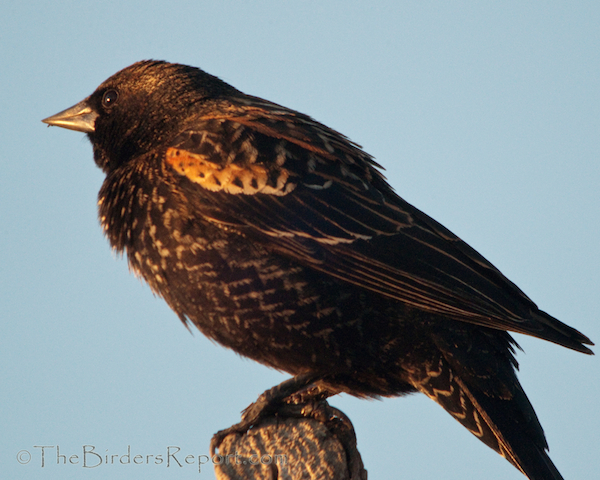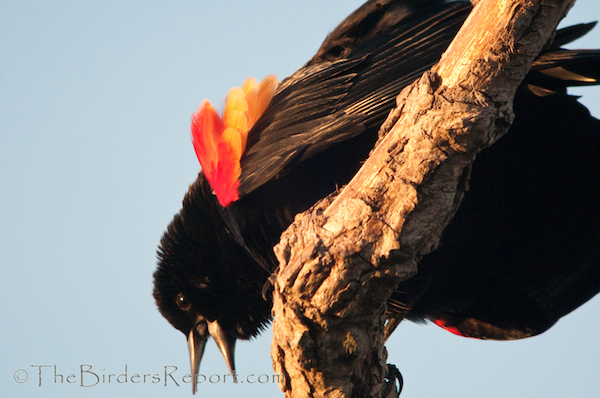Just the mention of the name conjures notions of fear and loathing in some folks, like farmers.
 Red-winged Blackbird (Agelaius phoeniceus) Male (click on photos for full sized images)
Red-winged Blackbird (Agelaius phoeniceus) Male (click on photos for full sized images)
This time of year, Red-winged Blackbirds are gathering on nesting grounds in wetlands but also in uplands and agricultural habitats.
In about six to eight weeks, depending on your location, you may see females with beaks full of insects like this one on her way to feed hatchlings.
Right now though, you would most probably see flocks of Red-winged Blackbirds preparing to mate and nest.
The male will perch atop cattails in wetlands (above) and stake out his territory. He will also chase females with his bright epaulets displayed during mating season.
The juvenile male is not a threat to the adult male’s territory and seldom elicits a response.
Red-winged Blackbirds are known for their polygynous social system where the male may have as many as fifteen females nesting in his territory…
and so the male defends his territory with several different displays.
The most common of these displays is the “Song Spread” sometimes used with no provocation.
He will also use a “Crouch” display, lowering his head with epaulets erected and wings drooped.
Here he is in full song mode. I don’t know if he is singing to a female or simply singing because another male flew over his territory. Sometimes the male Red-winged Blackbird will sing with no obvious recipients in sight!
Here are a couple of videos of male Red-winged Blackbirds singing. The first was shot at Delevan National Wildlife Refuge where the photos were taken. The male in this first video was a bit shy compared to the male in the above photos who came in later. You will notice that this male doesn’t erect his epaulets in a full display. He may be a younger male or just not sure of himself in this situation.
httpv://www.youtube.com/watch?v=MFns9D-l_xs&feature=youtu.be
This male was taped at Lema Ranch and shows a full Song Spread display as he sings. You will also hear a strange call in the background which is a Great-tailed Grackle.
httpv://www.youtube.com/watch?v=O2EL4vUNrB4&feature=plcp&context=C4ae39e1VDvjVQa1PpcFPTbYelErsJhAr6skZLW0XDm1dJqgSu6rU%3D
I was rather distraught when I read Birdchick’s post recently and discovered that not thousands but millions of Red-winged Blackbirds are grouped with European Starlings and killed by the United States Department of Agriculture every year! There were some interesting comments on that post you might want to read also.






















How can you mix up a starling with a red-winged blackbird? They don’t really look anything alike! Good grief. Great pictures. I hardly ever see RWB females.
It’s not a matter of mistaken identity. Starlings often join winter flocks of various blackbirds, and these flocks are specifically exempt from the Migratory Bird Protection Act. Until 2011 Rusty Blackbirds were included in this exemption as well, though if subsequent control efforts took any specific steps to avoid killing them I haven’t heard about it.
@Dawn Koyomi is correct. The USDA lumps Blackbirds, Grackles and Starlings together, even though European Starlings are a non-native species which is not protected by the Migratory Bird Treaty Act, and all other Blackbirds and Grackles are native species which would normally be protected. You can read about their practices here. If you have ever seen huge flocks of Blackbirds and Starlings you must realize that government agencies will never be able to discern Rusty Blackbirds form the other birds that all flock together, therefore the decline in Rusty Blackbirds is sure to increase over the years.
@Larry: With our back-to-back Red-winged Blackbird posts we must be proof that great minds think alike, right? Great post!
@Corey thanks. I don’t see how any other conclusion could be drawn from this happenstance!
I was recently surprised to see three RWBBs flying by my window in Sunnyside, Queens. The touch of color was refreshing, as mostly we just get starlings, house sparrows, and pigeons.
I almost did not become a birder because of a Red-winged Blackbird. For some reason, a male flew right at me while I was in the middle of a jog in my local park, and pecked me right at the top of my skull. Ouch! Those bills are very sharp.
Beautiful images and post, Larry. Blackbird and Starling detractors also don’t tend to mention that the nesting/baby diet tends to be insect-based, including insects that prey on crops. But the crop damage is considered to outweigh the benefits. It’s always distressing to me that lethal methods are first resort, when measures like reducing roost access around crops could at least be tried initially.
@Michael it’s always nice to get some different species in the yard!
@Donna I’m glad that incident did not deter you from birding. It was probably during breeding season and he as defending his territory or had a nest near by. They do have very sharp beaks and I bet that did hurt!
@Ingrid so much of “wildlife management” is distressing to me because usually the only thing taken into account is the effect the decisions have on humans, rather than the consequences to the wildlife, which, by the way, usually have consequences for we humans in the long run.